
views
Emptying out the Tank
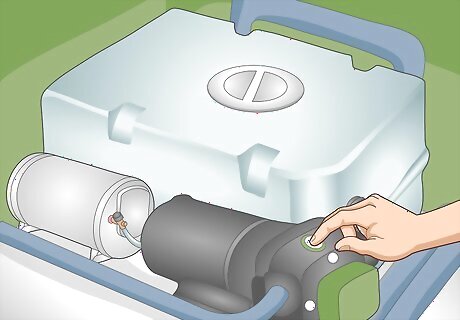
Turn on your boat’s water pump. Before you clean your boat’s tank, you’ll need to empty out the stale water inside. If your water pump isn’t already on, turn it on so that you can drain your tank completely. The location of the pump and water tank varies from one boat to another. If you’re not sure where to look, consult a schematic of your boat or your owner’s manual, if you have it.

Open your taps and let the water run out. Turn on any taps that are connected to your water tank. Let them run until no more water comes out. Listen for air coming out of the taps. This will tell you that the tank is empty.

Shut off the pump to keep it from burning out. After the tank is empty, switch off your pump to stop it from cycling. This will help prevent the impeller from wearing out. Many boats have pumps that automatically turn on after the water pressure drops below a certain level. This is meant to keep your water moving as the level in the tank gets lower.
Removing Dirt and Residue

Open the cap on the tank. Locate the access cap on your water tank and twist it off. It should be clearly marked as the cap for the water tank (rather than the fuel or waste tank). This will allow you to access the inside of the tank so that you can inspect and clean it. In some cases, the cap might be difficult to remove. You may need a special tool to open it. Consult the user manual for your boat or your specific water system.
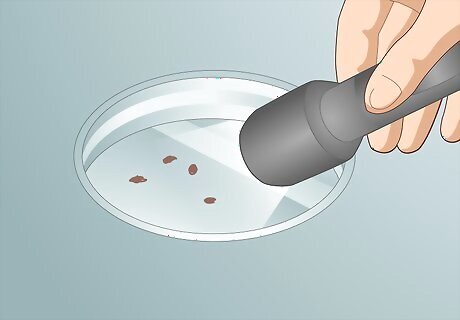
Use a flashlight to look for dirt in the tank that needs to be cleaned out. Shine a flashlight through the opening of the tank and look for obvious dirt, algae, mold, scale, or sediment on the sides and bottom of the tank. If any of this is present, you’ll need to clean it out before disinfecting and refilling your tank. If you’re able to get your hand in through the opening of the tank, feel the inside walls. If they feel slick or slimy, that’s a sign of bacterial buildup.
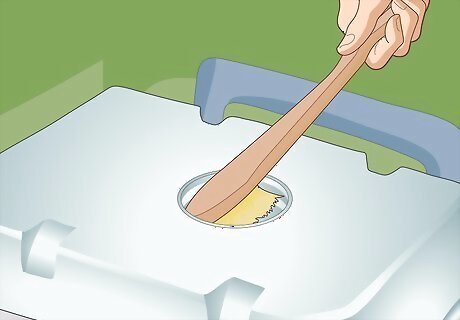
Scrub out the tank with a long-handled brush or power washer. Take a long-handled scrub brush and a little dishwasher detergent and scrub away any grime on the sides and bottom of the tank. Alternatively, you can hose it down with a power hose attached to a clean source of water. Make sure you get into the corners and the hard-to-reach spaces at the top of the tank. If you use a power washer, you’ll need some angle attachments to get into hard-to-reach corners.
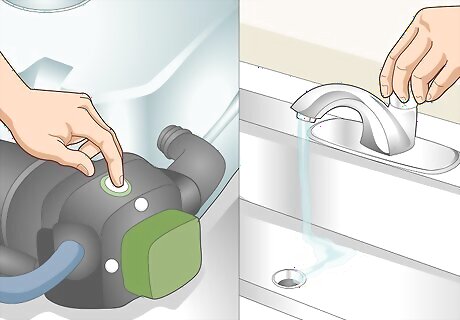
Turn on the pump and drain the tank. Switch the pump back on and open the taps to drain any dirty water and cleaning solution out of the tank. Wait until the water drains completely, then shut off the taps. If you emptied the tank completely the first time, it will probably take a few minutes for the water to start flowing again since there will be air in the pipes.
Disinfecting the Tank
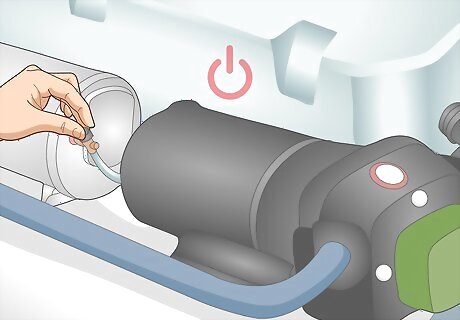
Turn off your pump and hot water heater. Once the tank is completely empty again, you can begin the process of disinfecting it. Shut off your pump and turn off the hot water heater if your boat has one. Consult your user manual if you’re not sure where the water heater is located.

Remove and clean any filters or faucet aerator screens. If there are any filters or carbon canisters attached to your water tank, take them off. If the filters appear dirty or haven’t been changed in a while, clean or replace them according to the instructions for your particular filter. Take the aerator screens out of the faucets and wash those, as well. To remove your faucet aerators, unscrew them with a wrench. Clean the aerators with hot, soapy water and a scrub brush. If there are a lot of mineral deposits on the screen, you can remove them by soaking the aerator in white vinegar for a few minutes before scrubbing it. If your pump has a protective mesh strainer, leave that in place. It will help protect your pump during the cleaning process. If your water tank has a vent hose and screen, detach those as well. Clean them with hot, soapy water if they appear dirty.
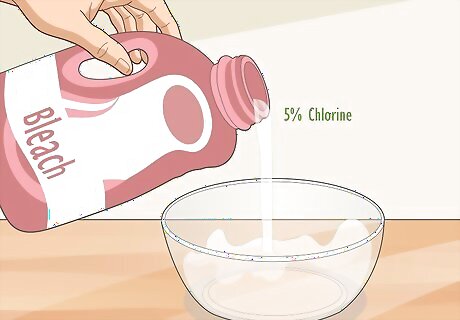
Measure out enough 5% bleach to make a 50 ppm solution in your tank. The cheapest and easiest way to sanitize your boat water tank is with household chlorine bleach. Use a 5% chlorine bleach product and pour enough into a bucket or other container to make a 50 ppm (parts per million) solution, based on the size of your tank.Warning: Never mix bleach with other household cleaners, since it could create toxic chlorine fumes. Always use bleach in a well-ventilated area. You can use this chlorine calculator to determine the correct amount of bleach to use: https://www.publichealthontario.ca/en/health-topics/environmental-occupational-health/water-quality/chlorine-dilution-calculator. For example, if you have a 50 US gal (190 L) tank, you’d need to use about 6.7 fluid ounces (200 mL) of bleach.

Mix the bleach with 1 gallon (3.8 L) of water. Before you pour the bleach into your tank, combine it with clean water. This will help distribute the bleach more evenly through your tank. Combining the bleach with water before you pour it in will also help prevent corrosion if your tank is aluminum.
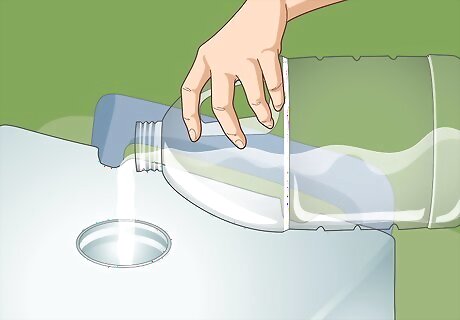
Pour the bleach and water mixture into the boat tank. Add your mixture slowly and carefully to the empty tank. You may find it helpful to use a funnel. Alternatively, you can fill the tank with fresh water before adding the bleach to the tank.
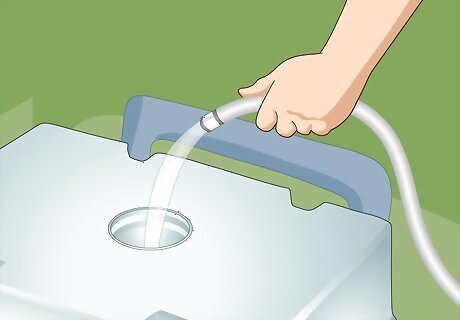
Top off the tank with clean, drinking-quality water. Use a clean source of potable water, such as a filtered dockside hose, to fill up your tank after you put the bleach inside. If possible, stir the water around with a clean implement (like a long spoon or stirring rod) to distribute the bleach. If your tank has a vent, let a little of the water and bleach solution spill out through the vent in order to sanitize the vent line. If the vent is exterior, put a bucket or other container under it to keep the bleach solution from entering the water outside your boat.

Switch the pump back on and let the water run until you smell chlorine. Turn on the pump and open all the taps on your boat, starting with those farthest from the pump. Allow the water to run for a few minutes until you notice a smell of bleach, then close the taps. Leave the pump on. It may take a few minutes for the pump to push all the air out of the lines and get the water flowing again.

Let the bleach solution sit in the tank for 12 hours. You’ll need to leave the bleach in the tank for several hours to do its work and kill any lingering mold, algae, or bacteria in your water system. Allow it to sit overnight or for a full day before flushing it out. If you don’t have time to let the bleach stay in your water tank for a full 12 hours, try to leave it for at least 4 hours.

Refill and drain your tank 2-3 times or until you can’t smell bleach. Drain your water tank and refill it again with fresh, clean water. Then, empty your tank again. Do this 2 or 3 times, or until you no longer smell a bleach or chlorine odor when the water is running. If you still smell a hint of bleach after flushing and refilling the tank twice, add 1 teaspoon (4.9 mL) of hydrogen peroxide per 20 gallons (76 L) of tank capacity and flush the tank again. The hydrogen peroxide should neutralize the remaining bleach.
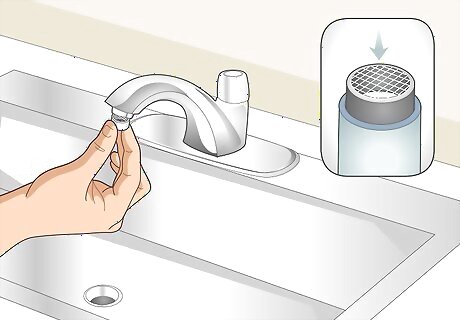
Replace the filters and vent screen. Once the water is running fresh and clean, replace any parts of the water system you removed during the cleaning process. This may include the filters or carbon cartridges, the vent screen and hose, and your faucet aerator screens.

Turn the pump and water heater back on and open the taps to let air out. Switch everything back on and open all the taps, both hot and cold. Let the taps run until all the air is out of the system and the water flows smoothly. Start with the tap farthest from the pump and work your way to the closest one. Make sure to let the air out of each tap to get your system working properly again.
















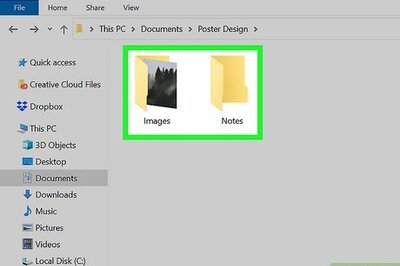



Comments
0 comment